When distinguishing butterflies and moths, there is no perfect method. Any distinguishing features have exceptions. In other words, butterflies and moths are actually in the same group of insects called Lepidoptera.
However, here are some of the characteristics which can be used to separate most of the butterflies and moths.
A butterfly or a moth? Confusing group of moth, Castonia, from South America.
●Butterfly flies during the day, moth flies during the night?
In general, this statement is true. However, some butterflies tends to fly at dusk and many moths fly during the day time. Some butterflies even come light during the night, just like many moths do.
●Butterfly has club-shape antennae and moth has comb-like or pointed antennae.
This is one of the best way to separate butterflies and moths. Most of the butterflies excluding Skippers, have the club-shape antennae.
Meantime, moths has pointed antennae and many male moths has comb-like antennae. But some moth, such as Castonia from South America, has club-like antennae.




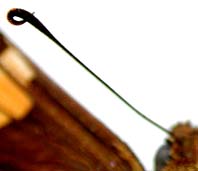

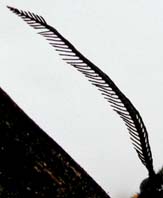
●Butterflies rest with its wings closed and moths with its wings open?
As shown in photo below, many moth rests on wall or leaves with its wings open. This is very typical moth posture. Some of the butterflies such as Morning Cloak shown below also rest with its wings open. Many butterflies open their wings especially early in the morning when they try to absorb heat from sunshine.
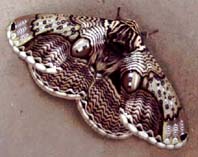 ▲Typical moth posture |
 ▲Mourning Cloak rest with its wings open |
●Butterflies are pretty and moths are dull?
Many moths found in temperate region are brown and are dull-looking. Since most of them are night flyers so they do not need colorful wings. However, some of the day-flying moths has spectacular color than some of the butterflies. These moths from tropical forests of South America and madagascar are some of the best examples. Also, there are lots of dull color butterflies in the world.
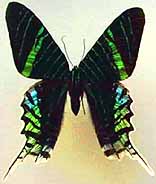

南米に生息する美しいウラニア属の蛾とマダガスカル島に生息するニシキオオツバメガ
●Moths have thick body?
写真のように胴体がやたら太いのがいたらまず間違いなく蛾でしょう。ただし、同じ様な形で間違われやすい種類にはセセリチョウの仲間がいます(もっとも、セセリチョウを蝶扱いしない学者もいますが)。また、多くの蛾は蝶のようにスリムな体を持つものもいますので、決定的区別法とは言えません。

蛾は胴が太い?
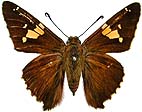
蝶も体が太い種類がいる。
●蛾は鱗粉が剥げやすい?
確かに、鱗粉が簡単に剥げる種類は蛾に多い様です。ただし、この方法では蝶と蛾は区別できません。
●前翅と後翅をつなげる方法
蝶も蛾も、羽を使って飛ぶときは、前翅と後翅をまるで一つの羽のように動かします。トンボやカブトムシが空を飛ぶとき、前翅と後翅を別々に動かすのとは対照的です。前翅と後翅を一緒に動かすのに、蝶の場合、後翅基部の前縁が大きく前方にせり出ています。一方蛾は「翅棘(しきょく)」といった棘が後翅より出ていて、前翅にあるフックのような突起に引っかかっています。これは、殆ど例外がなく、蝶と蛾を区別する良い方法といえます。ただし、この場合は蝶や蛾を捕まえてよく観察しなければ見えません。
因みに蝶でこの翅棘を持つ例外として良く知られている種類にオーストラリアに生息するラッフルズセセリがいます。
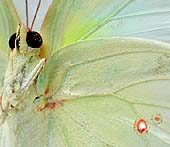 蝶は後翅が前に張り出す。
蝶は後翅が前に張り出す。 蛾は、棘が出ており、前翅とつながる。
蛾は、棘が出ており、前翅とつながる。日本に生息する、蝶と蛾であれば殆どがこの様な点で見分けることが出来ますが、これが完璧というわけではないので気を付けて下さい。日本ではともかく、世界の蝶や蛾を調べるときはあてになりません。
結局、蝶と蛾は同じ「鱗翅目」の仲間なのです。よって、分類学上で蝶と蛾を区別するには、「科」で分けることになります。すなわち、分類のページで紹介している科(セセリチョウ科、アゲハチョウ科、シロチョウ科、シジミチョウ科、シジミタテハ科、タテハチョウ科)に属するものを「蝶」と呼び、そのほかを「蛾」と呼んでいるのです。
本当は蝶と蛾は区別できないほど似ている仲間なのです。外国では、日本語や英語のように蝶と蛾を別々に呼ばず、一つの言葉で言い表している国が多くあります(フランス・ドイツ・インドネシア・ネパールなど)。また、英語圏の国では、時々セセリチョウ科の蝶をスキッパーズ(Skippers)として、蝶と蛾から区別することもあります。
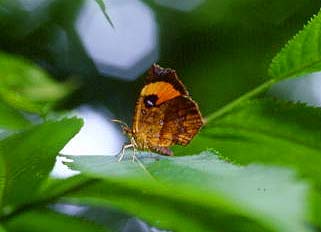
A moth which looks very much like a butterfly.